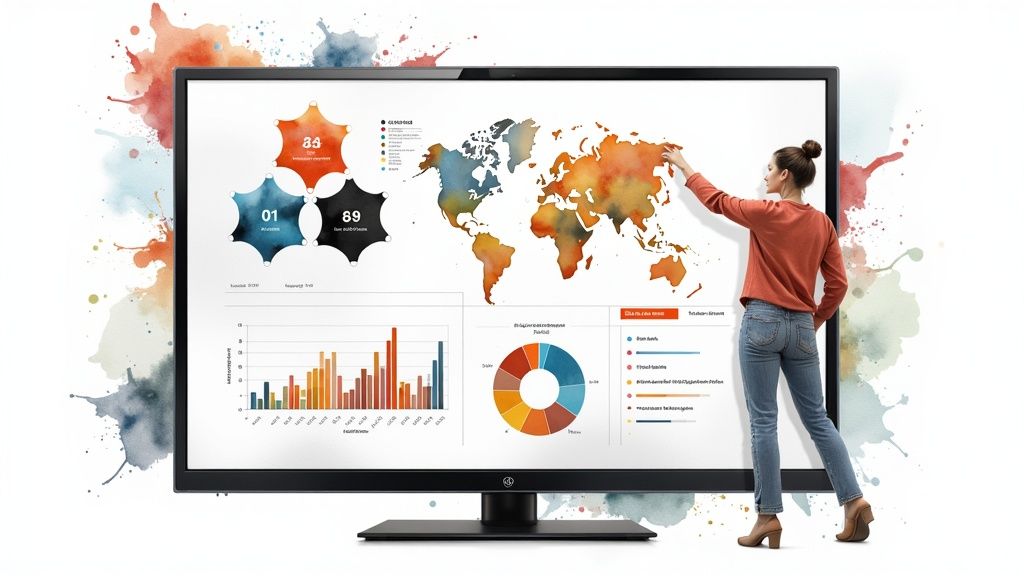
Innovation Performance Indicators: A Strategic Guide to Measuring Your Success
Understanding the Power of Innovation Metrics

Every organization needs innovation to grow and thrive. But measuring innovation success requires more than gut instinct – it demands clear, measurable indicators. Innovation performance indicators give organizations concrete data to evaluate their innovation efforts and make informed decisions.
Why Traditional Metrics Fall Short
Standard business metrics like revenue and profit only tell part of the story. While these numbers reflect past successes, they don't capture the potential of current innovation initiatives. A company might show strong financial performance today but lack new products in development, putting future growth at risk. This gap shows why we need specialized metrics focused on tracking innovation.
The Importance of a Holistic Approach
Measuring innovation effectively requires looking at both numbers and insights. This means combining quantitative data like product launch statistics with qualitative feedback from customers about new features. Financial measures also play a key role – one example is Product Portfolio NPV (Net Present Value), which calculates what future product earnings are worth today. For instance, a $10 million NPV indicates that expected future cash flows from current products equal $10 million in present-day value. Learn more about innovation measurement here.
Key Categories of Innovation Performance Indicators
A complete innovation measurement system should track these essential areas:
- Input Metrics: Track resources invested in innovation, including R&D budget and innovation staff headcount, to monitor resource use
- Process Metrics: Measure how efficiently innovation happens, like time-to-market for new products and number of ideas generated
- Output Metrics: Count tangible results like new patents, product launches, and revenue from new offerings
- Outcome Metrics: Assess broader impact through market share changes, customer satisfaction scores, and brand perception
By monitoring these connected metrics, companies can see their innovation performance from all angles. This comprehensive view helps identify what's working well and what needs improvement. The end goal is creating a measurement system that not only tracks but actively encourages innovation, supporting long-term success and market leadership.
Mastering Time-Based Innovation Metrics

Successfully managing innovation requires careful attention to timing and execution. Understanding key innovation performance indicators helps teams track and improve their development processes. These metrics reveal vital insights about how effectively your organization moves from ideas to implementation.
The Importance of Speed and Quality
Finding the right balance between speed and quality is essential for innovation success. Just as rushing construction of a building's foundation leads to problems later, hurrying innovation without proper quality controls creates risks. The goal is delivering solutions quickly while maintaining high standards. Getting this balance right helps protect your brand and ensures sustainable growth.
Key Time-Based Metrics
Several core metrics help track innovation speed and efficiency. Time-to-Market (TTM) measures how long it takes to go from initial concept to market launch. A shorter TTM indicates better competitive positioning and faster response to market needs. For example, tech companies that reduce TTM by a few months often gain significant market share advantages compared to slower competitors. Learn more about Time-to-Market metrics here. Another key measure is Cycle Time, which tracks duration of individual innovation phases.
Optimizing Your Innovation Rhythm
Regular monitoring of time-based metrics reveals opportunities to improve your innovation rhythm. For instance, if testing cycles run long, you might add automation or resources to accelerate that phase. Taking action on these insights leads to faster development cycles and better market responsiveness. The data helps pinpoint exactly where processes need refinement. Modern innovation management platforms provide tools to collect and analyze these metrics, enabling smarter decisions about process optimization.
Customizing Innovation Metrics for Your Industry
Different business sectors need different ways to measure innovation success. Just like a chef uses different tools than a mechanic, each industry requires specific metrics that match how they operate and what matters most to their business goals.
Industry-Specific Considerations
Companies across industries value different aspects of innovation based on their unique challenges and goals. Take fast-moving consumer goods (FMCG) companies – they focus heavily on time-to-market since consumer trends change quickly. Meanwhile, pharmaceutical firms prioritize thorough testing and regulatory compliance, making safety and effectiveness their key metrics. Software companies often concentrate on rapid testing cycles and user feedback, continuously refining their products based on real customer data.
Adapting Metrics for Maximum Impact
The key is aligning innovation measurements with what drives success in your specific field. For example, manufacturing companies often track operational innovation by measuring production efficiency gains and defect rate reductions. Service businesses, on the other hand, might focus more on customer experience metrics like satisfaction scores and service speed improvements.
The construction industry provides a clear example of industry-specific metrics in action. Research shows that innovations like prefabrication led to 34% faster completion times and 19% lower costs. This resulted in 7% higher overall productivity, with housing projects seeing the biggest gains at 11%. Learn more about construction innovation metrics in this comprehensive industry study.
Developing a Tailored Framework
Creating effective industry-specific metrics starts with clearly defining your innovation goals. From there, identify the key activities that drive those goals and select metrics that meaningfully track their performance. This focused approach helps pinpoint improvement areas and accelerate growth. Remember that tools like Derisky.ai can help customize and monitor these targeted metrics to guide your innovation strategy forward.
Building Your Innovation Measurement Framework

To turn innovation efforts into measurable wins, organizations need a solid system for tracking performance. This means moving beyond just picking metrics and creating a complete approach to measuring innovation success. Let's explore how leading companies build measurement frameworks that actually work.
Defining Your Innovation Objectives
The foundation of any good measurement system starts with crystal clear goals. Ask yourself: What specific outcomes do you want from your innovation program? Maybe it's faster product development, more revenue from new offerings, or increased market share. For instance, if market disruption is your aim, you might focus heavily on tracking time-to-market metrics. Having this clarity helps you pick the right metrics and keeps measurement tied to what really matters.
Selecting the Right Innovation Performance Indicators
After setting clear objectives, it's time to choose metrics that truly show progress. The key is picking a balanced mix of measurements across the entire innovation journey. Consider tracking:
- Input metrics – Like research and development investments
- Process metrics – Such as number of ideas generated
- Output metrics – For example, successful product launches
- Outcome metrics – Including market share gains and customer feedback
Implementing Your Measurement System
Getting your innovation performance indicators up and running takes more than just collecting numbers. You need:
- Clear Data Sources: Know exactly where each metric's data will come from – whether that's internal systems, market research, or customer surveys
- Team Training: Make sure everyone understands what the metrics mean and why they matter so they can make better decisions
- Smart Tools: Use platforms like Derisky.ai to automatically gather data and create dashboards, letting teams focus on insights rather than spreadsheets
Maintaining and Refining Your Framework
A measurement system isn't something you can set and forget – it needs regular tune-ups to stay useful. Check if your innovation performance indicators still match your goals and provide actionable insights. As your innovation program grows, you might need different metrics. Get input from key team members during reviews to keep the system relevant and valuable. This ongoing refinement ensures your framework keeps driving real innovation results.
Turning Innovation Data Into Strategic Decisions
Tracking innovation performance indicators is just the beginning of the process. The real power comes from analyzing this data to make informed strategic choices. Smart organizations know that raw numbers alone aren't enough – they need to convert these insights into concrete actions that drive growth and improvement.
Visualizing Innovation Performance
Clear data visualization makes complex information accessible and actionable. Just as a traffic map helps us understand city congestion better than raw numbers, well-designed dashboards and charts reveal hidden patterns in innovation performance indicators. This visual approach helps teams quickly spot bottlenecks, celebrate wins, and focus resources where they're needed most.
Predictive Modeling and Forecasting
Past data opens windows into future possibilities. Much like meteorologists use weather patterns to forecast conditions, companies can analyze their innovation trends to anticipate what's ahead. This foresight allows teams to prepare for challenges, adjust strategies early, and allocate resources more effectively. The result is better risk management and higher success rates for innovation initiatives.
Data-Driven Decision-Making Frameworks
A structured approach brings clarity to innovation decisions. For example, teams can develop specific criteria for evaluating new ideas based on innovation performance indicators. This removes subjective bias and ensures choices align with company goals. The process becomes transparent and repeatable, improving over time through continuous data feedback.
Building Engaging Reporting Systems
Good reporting connects data to action. Reports should tell clear stories that resonate with different audiences – from executives to project teams. Think of an effective infographic that quickly conveys complex concepts. Similarly, well-designed innovation reports keep everyone informed and aligned toward common goals. Tools like Derisky.ai can help automate this process, making it easier to collect, visualize and share your innovation performance indicators across the organization.
Preparing for the Future of Innovation Measurement

The methods for measuring innovation continue to evolve at a rapid pace. Companies need a solid understanding of emerging trends and tools to effectively track their progress. Rather than just adopting new technologies, organizations must fundamentally rethink their approach to innovation performance indicators.
The Rise of AI-Powered Analytics
Artificial intelligence has opened up new possibilities for data analysis in innovation measurement. AI systems can process enormous datasets to uncover hidden patterns and generate actionable insights. For instance, they can analyze customer feedback, market data, and competitive intelligence simultaneously to identify improvement opportunities. This allows companies to make data-backed decisions about their innovation initiatives.
Real-Time Performance Tracking
Traditional innovation reports often look backward, providing delayed insights. Modern businesses need immediate feedback to stay competitive. New innovation platforms offer live dashboards that monitor innovation performance indicators in real-time. This enables quick adjustments based on current data rather than outdated information. Think of it as having a navigation system for innovation – you can course-correct instantly when needed.
Beyond Traditional Metrics: Predictive Analysis
The next frontier in innovation measurement focuses on forecasting future trends, not just recording past performance. Advanced AI and machine learning tools analyze historical data to spot emerging patterns and predict market shifts. This helps companies get ahead of changes instead of just reacting to them. Organizations can use these predictions to shape their innovation strategy proactively.
Future-Proofing Your Innovation Measurement Systems
To build lasting measurement capabilities, companies should:
- Embrace Flexibility: Select tools that can adapt to include new metrics and data sources
- Prioritize Integration: Connect different systems to create a complete view of innovation performance
- Focus on Action: Convert data into clear steps that drive meaningful improvements
Following these guidelines helps organizations stay nimble as innovation measurement continues to advance. Regular updates to measurement approaches and tools are essential for long-term success.
Ready to improve how you track innovation? Derisky.ai provides a complete platform for monitoring and optimizing your innovation performance indicators. See how we can help strengthen your innovation strategy at derisky.ai.







